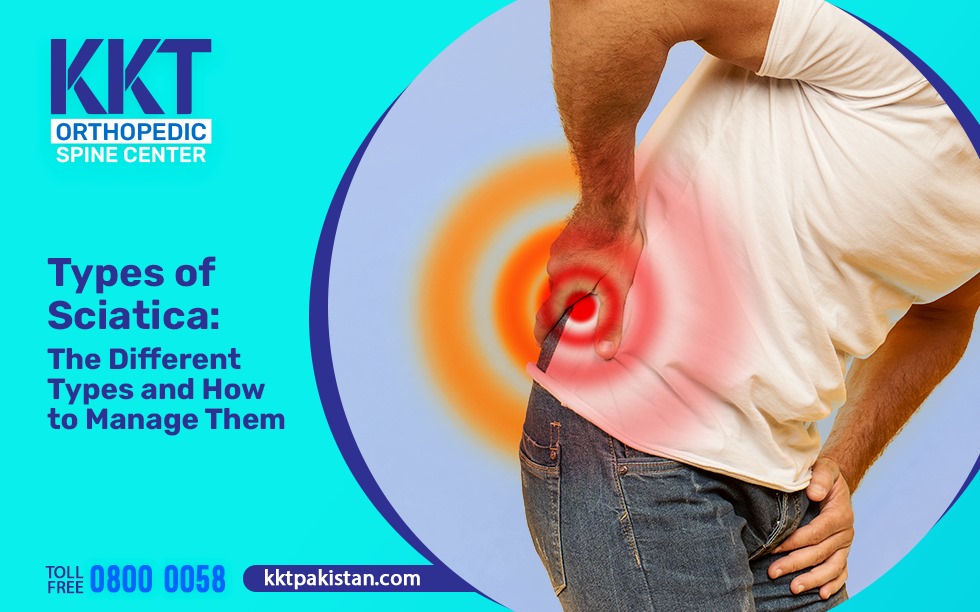Types of Sciatica: The Different Types and How to Manage Them
Sciatica is a common form of nerve pain that affects nearly 10-40% of the population. Any inflammation, irritation, or compression of the sciatic nerve root can lead to sciatica. It may result in pain in the lower back that radiates down the leg.
There are various types of sciatica based on symptoms and the duration of the pain. If you are experiencing pain radiating down the leg, continue reading to learn more about the different types of sciatica.
How Many Types of Sciatica Are There?
Various types of sciatica are categorized based on the duration of symptoms in the affected leg, such as acute, chronic, bilateral, alternating, and mechanical sciatica pain.
Acute pain lasts 4 to 8 weeks or less and is often manageable with at-home treatments. Chronic pain lasts for more than 8 weeks and requires medical attention. Alternating is a rare form of sciatica pain that affects both legs. It causes tingling and numbness that switches between the right and left leg. Bilateral sciatica occurs when both legs are affected by sciatica.
The 4 Stages of Sciatica
The four stages of sciatica are categorized by pain severity. It starts with mild discomfort, which may worsen the condition if prolonged. Let’s dive deeper to learn more about these stages of sciatica.
Initial phase
Stage 1 is an initial phase of mild discomfort. An individual might experience lower back and buttocks discomfort radiating toward one leg. This pain often worsens with specific movements such as bending forward, picking up an object from the floor, or sitting for an extended period. Other concerning symptoms are a tingling sensation and numbness in the legs.
Mild pain often gets better with rest and gentle exercise. If it persists, you can use over-the-counter medicines that might be helpful.
Intense Pain
Stage 2 is a phase of Intense pain. Individuals might experience sharp, shooting, or stabbing pain along the path of the sciatic nerve. As sciatica progresses, the pain becomes more intense and debilitating, causing difficulty in controlling leg movements and muscle weakness. An individual might have trouble performing daily activities or falling asleep comfortably.
Physical therapy, ice, or heat packs can help reduce the pain, and doctors might prescribe you some medications to alleviate the symptoms.
Chronic Pain
Stage 3 chronic sciatica pain. The pain persists and affects the person’s quality of life, making engaging in daily activities or work responsibilities difficult. A person may experience discomfort for weeks or months, leading to muscle atrophy or weakness.
When all conservative treatments no longer work, a doctor might prescribe surgical interventions, epidural injections, or nerve block procedures.
If you are scared of surgical procedures, KKT Treatment might be a better option. It applies specific soundwave frequency to the affected area, which helps realign the spine to relieve compressed nerves and alleviate sciatica pain.
Recovery Phase
Stage 4 recovery phase. Even after successful treatment, some individuals might experience recurrent episodes of sciatica. The primary reasons for these flare-ups are repetitive strain on the lower back, spinal stenosis, and spinal disc degeneration. It presents the symptoms from earlier stages with exacerbation of pain, numbness, and weakness in the leg.
Self-care tips such as gentle exercises, correct posture, stretching, and rest help alleviate the symptoms. If the symptoms persist or recur with sciatica, it is important to consult the healthcare provider to address them to prevent long-term complications.
Acute vs. Chronic Sciatica: The Key Differences
Pain lasting from 6 weeks to 8 weeks is classified as acute pain. It is often accompanied by symptoms such as stabbing or shooting pain that radiates to the legs. Acute pain usually improves on its own with preventive measures, such as avoiding sitting for extended periods, performing exercises or yoga, and maintaining correct posture.
Chronic pain lasts longer than 8 weeks. This condition develops when the sciatic nerve is compressed or irritated for longer due to other conditions, such as herniated discs or spinal stenosis. Chronic pain can affect mobility, limit physical activities, and reduce overall quality of life.
What Is the Difference Between True Sciatica and Pseudo Sciatica?
Pseudo-sciatica is a condition that arises when peripheral regions of the sciatic nerve are compressed. The compression is usually caused by tension within the gluteal muscles. Patients with pseudo sciatica often experience extensive pain in the hip that persists whether they are walking or at rest.
True sciatica refers to pain caused by compression of the sciatic nerve, which radiates down the leg. Pseudo sciatica, on the other hand, does not involve direct compression, and this pain does not radiate below the knee.
How Do I Know What Kind of Sciatica I Have?
The most definitive way to know what kind of sciatica you have is to consult a doctor. The doctor might ask about your symptoms and the duration of the pain onset. The doctor will assess your range of motion, muscle strength, and reflexes and perform a straight leg raise test to check for nerve root compression.
In some cases, the doctor might recommend diagnostic tests (MRI, X-rays, physical examination) to analyze the spine’s condition.
Sciatica Myths and Misconceptions
Is surgery the only option for treating sciatica? There are various treatment options depending on the cause and severity of the pain. You can choose from medicinal to non-invasive treatments. Surgery is the last resort for treating sciatica when other options have failed.
Is sciatica always a result of a herniated disc? A herniated disc is not the sole cause of sciatica. It can also be caused by piriformis syndrome, nerve compression, muscle tension, or bone spurs.
Can sciatica be prevented? Yes, sciatica can be prevented by adopting healthy habits such as eating a balanced diet, adapting to a physically active lifestyle, maintaining correct posture, and switching to lifting weights with the proper technique.
KKT Treatment to Relieve Sciatica Pain
KKT provides noninvasive and nonsurgical treatment to diagnose sciatica pain and its causes. It is a revolutionized form of re-aligning the spine to its normal position using noninvasive sound waves. This treatment method helps to ease the pain and release pressure on the sciatic nerve, providing long-lasting relief.
This spinal re-alignment reduces nerve pressure by relieving compressed nerves at various levels and promoting overall spinal health.
To learn more about sciatica and its treatment, visit our experts at one of our centers, schedule an appointment, or dial 0800-00-558.
Conclusion
Based on the symptoms, there are different types of sciatica: acute, chronic, bilateral, alternate, and mechanical. Sciatica is classified into two categories: pseudo sciatica and true sciatica. The main difference between them is that pseudo sciatica is not actual sciatica pain but mimics it. People with this condition often feel pain in the lower back and hip, and this pain does not radiate down the leg.
There are treatments available for sciatica, such as acupuncture, chiropractic treatment, physical therapy, and KKT Treatment.
Frequently Asked Questions (FAQs):
How many types of sciatica are there?
Sciatica is classified according to the duration of symptoms and the affected leg, resulting in categories such as acute, chronic, bilateral, alternate, and mechanical sciatica pain.
What are the four stages of sciatica?
The four stages of sciatica are the initial phase when pain begins, the intense phase, the chronic phase, and the recovery phase.
What is the difference between true sciatica and pseudo-sciatica?
True sciatica refers to pain caused by compression of the sciatic nerve, which radiates down the leg. Pseudo sciatica, on the other hand, does not involve direct compression, and this pain does not radiate below the knee.






